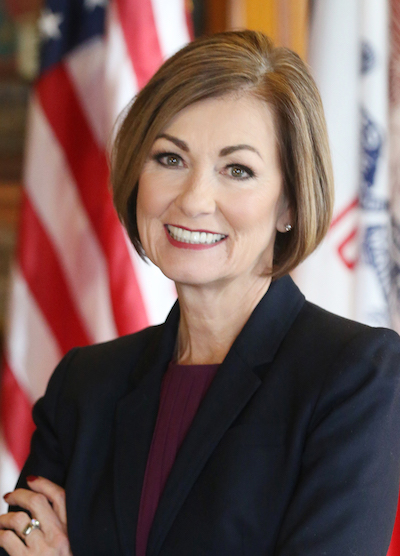Jan Flora is Professor Emeritus at Iowa State University.
On January 9, new cases of COVID-19 reached an all-time high in Iowa. Governor Kim Reynolds may have known that when she gave her Condition of the State address two days later. By barely mentioning the pandemic, she attempted to relegate it to the past.
With the Omicron variant now dominant, COVID-19 cases were modeled to peak on January 15. Coronavirus-related hospitalizations are now near 1,000, the highest point since early December 2020. Iowa faces a grave hospitalization crisis that may not ease before March.
There is a cultural dimension to this crisis. Remember 2020, when teachers, health professionals, and meatpackers were deemed essential workers? Now they are derided for wanting safe workplaces. Mandatory masking, vaccinations, or regular testing will not prevent economic recovery. “Individual freedom” to go unvaccinated and unmasked does not trump the need to bring the pandemic under control.
Reynolds believed the meatpacking executives when they said they were managing the virus. Forced to do mass testing in spring 2020, the Tyson plant in Perry found 58 percent of its employees had COVID-19, far above the lax 10-percent threshold set arbitrarily by Iowa Department of Public Health (IDPH).
The virus spread from plant to community. Even now, the Iowa counties with the highest rates of cumulative COVID-18 infections per capita had meatpacking plants or supplied many workers to a plant in an adjacent county. Buena Vista County regularly ranks among the top five counties in vaccination rates, but because of the initial spread from the Tyson plants to the community of Storm Lake, it still tops all other Iowa counties in cumulative cases per capita. Our governor sided with corporations over the workers.
The IDPH defined a nursing home outbreak as three or more cases among residents. Some states report even a single employee or resident case as an outbreak, and national data suggest that employees working at multiple nursing homes contributed to virus spread among vulnerable populations.
Although many of Iowa’s early COVID-19 fatalities occurred in nursing homes, the Republican trifecta shifted its concern from residents to corporate nursing homes. In June 2020, the GOP-controlled legislature approved and Reynolds signed a bill protecting nursing homes from most COVID-19 lawsuits. The following week, the Iowa AARP called for mandatory testing of nursing-home residents and workers.
By late November 2020, 143 nursing homes were experiencing outbreaks, even by IDPH’s definition. But the agency stonewalled media requests for details on staff deaths in those facilities. (Editor’s note: Sara Anne Willette compiles that data on her independent website Iowa COVID-19 tracker, using federal databases.)
With the Omicron variant on the loose, 56 Iowa nursing homes now have outbreaks, according to the IDPH, up from 16 in mid-December. Will our governor heed the recent U.S. Supreme Court ruling upholding the federal vaccine mandate for nursing home workers, or will outbreaks, infections, and deaths continue to climb?
In May 2021, Reynolds said, “There’s no reason for us to continue to fear COVID-19 any longer. We know how to manage it. Individuals can be trusted to make decisions that will keep us on a path forward.” Two weeks earlier, she announced on Fox News that she had turned down $95 million in federal government funding earmarked for testing in the public schools.
Also last May, Reynolds signed bills banning local mask mandates by public school districts and local governments, and prohibiting local governments from issuing COVID-19 “vaccine passports,” and businesses from requiring proof of vaccination from customers before serving them. The state has since been hit by the Delta and Omicron variants, each spreading faster than previous ones.
In choosing a Johnson & Johnson vaccine and booster shot for herself, the governor accepted the infectious-disease experts’ consensus that we would be better off if all were vaccinated. But rather than protecting her followers, she made a cold-hearted political calculation: that all-voluntary measures for slowing the spread of COVID-19 would ensure her victory in November 2022. The resulting hospitalizations, deaths, and chronic “long COVID” ailments, are inflicted disproportionately on the unvaccinated.
The Republican trifecta has failed to use common-sense measures to protect Iowans against recent variants. Will Iowa again be a day late and a dollar short when the next variant comes around?
Jan Flora is Professor Emeritus at Iowa State University (College of Agriculture and Life Sciences). He has a Ph.D. from Cornell University in Development Sociology. He was Program Advisor for Agriculture and Rural Development for the Ford Foundation for Spanish-speaking South America from 1978 to 1980, living in Bogotá, Colombia. He is completing a research/outreach project on Latino farmworkers in northwest Iowa. He is co-author with Cornelia Flora of Rural Communities: Legacy and Change, now in its fifth edition. He grew up on a wheat and cattle farm in Kansas. He currently resides in Ames.


